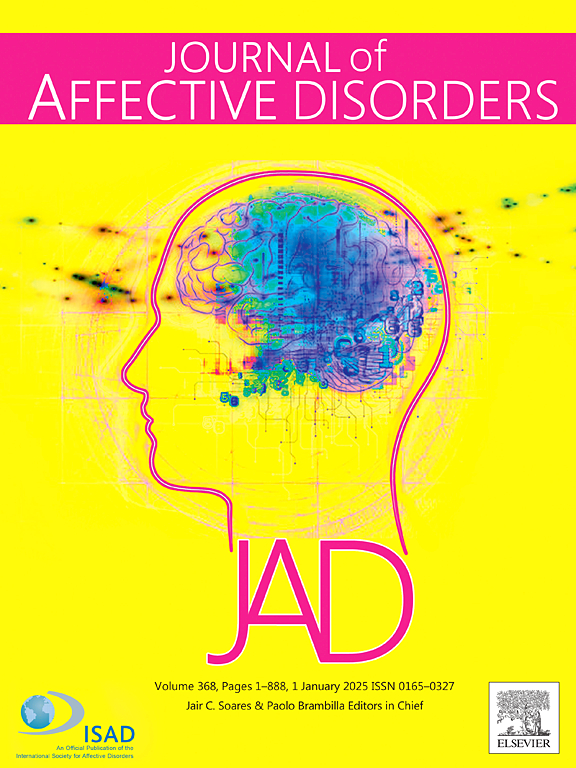Beyond impulsivity, predicting non-suicidal self-injurious behavior in adolescents: A network approach
IF 4.9
2区 医学
Q1 CLINICAL NEUROLOGY
引用次数: 0
Abstract
Background
Impulsivity is a key factor in the onset of non-suicidal self-injury (NSSI) during adolescence; however, the impact of other psychological factors on this relationship remains uncertain.
Objectives
This study mainly explored the complex network relationship between general mental health status and NSSI in adolescents.
Methods
We surveyed 1127 adolescents regarding their experiences with NSSI and conducted detailed assessments of their mental health status, attitudes toward animals, and demographic characteristics, including age, gender, Body Mass Index, socioeconomic status, and online-time. Complex interactions and potential patterns among NSSI, general mental health status, attitudes toward animals, and demographic variables were examined using logistic regression analysis, GLASSO network and Bayesian network analysis.
Results
A significant association was observed between impulsive tendencies (ImT; odds ratio [OR]: 1.62; 95 % confidence interval [CI]: 1.49–1.76) and physical symptoms (PhS; OR: 1.34, 95 % CI: 1.27–1.43) with NSSI in the training set. Network analysis identified anxiety about people (AaP), PhS, and ImT as central features. Moreover, Bayesian network analysis suggested that ImT has a direct associated with NSSI, while AaP and PhS exert an indirect influence on NSSI through the mediation of ImT.
Conclusion
Beyond the direct and potent link between impulsivity and non-suicidal self-injury, the study highlights that interpersonal anxiety and somatic symptoms have an indirect yet significant impact on non-suicidal self-injury, primarily mediated through the prism of impulsivity.
除了冲动,预测青少年的非自杀自伤行为:一种网络方法
背景:冲动是青少年发生非自杀性自伤的关键因素;然而,其他心理因素对这种关系的影响仍不确定。目的探讨青少年一般心理健康状况与自伤之间的复杂网络关系。方法我们调查了1127名青少年的自伤经历,并详细评估了他们的心理健康状况、对待动物的态度和人口统计学特征,包括年龄、性别、体重指数、社会经济地位和上网时间。采用logistic回归分析、glassso网络和贝叶斯网络分析,探讨自伤与一般心理健康状况、动物态度和人口统计学变量之间复杂的相互作用和潜在模式。结果冲动倾向(ImT;优势比[OR]: 1.62;95%可信区间[CI]: 1.49-1.76)和身体症状(PhS;OR: 1.34, 95% CI: 1.27-1.43)。网络分析确定了人际焦虑(AaP)、PhS和ImT是中心特征。此外,贝叶斯网络分析表明,ImT与自伤有直接关系,而AaP和ph则通过ImT的中介间接影响自伤。结论除了冲动性和非自杀性自伤之间的直接而有力的联系外,本研究强调人际焦虑和躯体症状对非自杀性自伤有间接而显著的影响,主要通过冲动性的棱镜介导。
本文章由计算机程序翻译,如有差异,请以英文原文为准。
求助全文
约1分钟内获得全文
求助全文
来源期刊

Journal of affective disorders
医学-精神病学
CiteScore
10.90
自引率
6.10%
发文量
1319
审稿时长
9.3 weeks
期刊介绍:
The Journal of Affective Disorders publishes papers concerned with affective disorders in the widest sense: depression, mania, mood spectrum, emotions and personality, anxiety and stress. It is interdisciplinary and aims to bring together different approaches for a diverse readership. Top quality papers will be accepted dealing with any aspect of affective disorders, including neuroimaging, cognitive neurosciences, genetics, molecular biology, experimental and clinical neurosciences, pharmacology, neuroimmunoendocrinology, intervention and treatment trials.
 求助内容:
求助内容: 应助结果提醒方式:
应助结果提醒方式:


